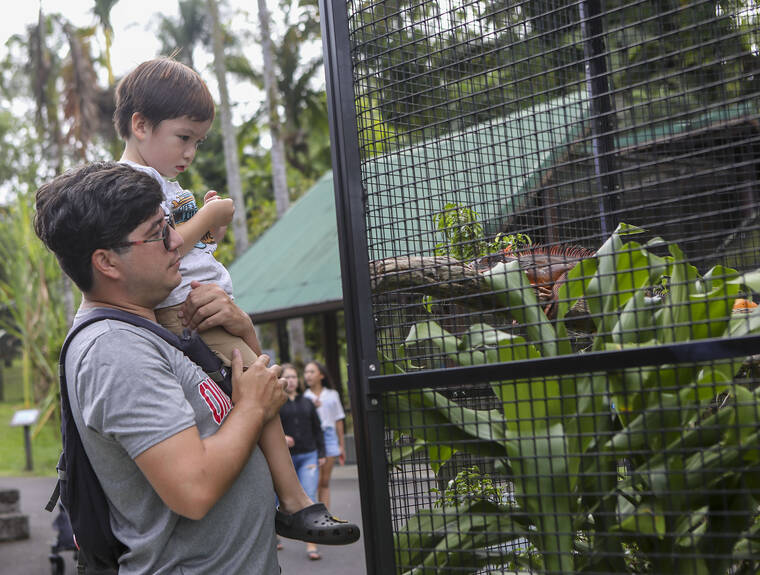Concerns linger over zoo fees: Dozens turn out for public hearing


Members of the public voiced concerns and offered suggestions during a hearing Tuesday night about proposed changes for the Pana‘ewa Recreation Center, including fees for entry to the zoo.
About 40 community members joined representatives from the Department of Parks and Recreation at the Aging and Disability Resource Center on Kino‘ole Street for the one-hour public forum, during which the county took feedback about topics concerning the Pana‘ewa Rainforest Zoo and Gardens and the Equestrian Center.
ADVERTISING
Honoka‘a native Shannon Matson said the majority of the activities her family took part in during her upbringing were only accessible because they were free, including the zoo.
She worried the cost of a $25 annual pass may lead to families not being able to attend the zoo together, because some families may only be able to afford such a pass for one parent, chipping away at the kind of core family experiences that shaped her local upbringing.
“The lessons of wildlife conservation and preservation, I think, should be accessible to all,” Matson said.
Matson recommended a free or reduced rate for low-income families, and was beginning to share her disagreements with multiple proposed zoo rules — including the need for mobility-assisting devices to be approved ahead of time and the prevention of running and skipping — when her allotted time ran out.
President of the nonprofit Friends of Pana‘ewa Zoo, Pat Engelhard, and former administrator of the Pana‘ewa Recreation Center, Pam Mizuno, both repeated concerns raised since the idea of zoo fees was introduced in November, namely that charging fees would deter the public donations that have long supported the zoo and the issue of money from fees going into the general fund as opposed to a zoo-dedicated special fund.
“I worked with the county for 22 years,” Mizuno said. “I know what happens to money in the general fund.”
Mizuno went on to voice a widely agreed upon point regarding who qualifies as kama‘aina, with the county’s proposed rules designating only county residents should pay the prices of $4 for adults and free entry for keiki and kupuna, while residents from other islands pay the tourist rates of $12 for adults and $5 per child.
“When we compare the charges for the Honolulu Zoo where we only pay $10, there’s some inequity there,” Mizuno said of Oahu’s zoo offering statewide residents the discounted rate of $10, while visitors to the islands are charged $13.
Some speakers had broader ideas about making the zoo more widely accessible.
Stanley Aoki, a Big Island resident of 60 years, suggested the county consider offering free zoo access to anyone of any age who has lived anywhere in the state of Hawaii for five years or more.
Attorney Susan Regeimbal introduced another suggestion that off-island guests could get the local rate if they attend the zoo with the Hawaii County resident they are visiting.
Several people tuned in via Zoom in addition to the in-person attendance, with 12 testimonies presented in-person about both the zoo and the equestrian center and two zoo-focused testimonies through the online meeting.
All testimonies were constrained to a three-minute, one-turn rule. Both Zoom testimonies on Tuesday echoed the in-person requests for little to no fees and the creation of a special fund, as did the majority of the written testimonies submitted to the county.
Pana‘ewa Recreation Center Administrator Mindy Runnells was unable to respond directly to those giving testimony due to the meeting’s structure of not being a place for discourse, but she did comment to the Tribune-Herald after the meeting.
She said the county had considered the statewide kama‘aina rate many were calling for before deciding to limit the discount to county residents to “strike a balance” between having a widely affordable zoo and utilizing the popular resource as a way to sustain and support county operations.
Runnells said fees going into the general fund could allow the county to elevate the zoo in ways its supporting nonprofit cannot, such as more staff, an expanded footprint of the facility, and new exhibits that may contain new species.
She said the zoo already has had recent additions such as native a‘lala crows, a second binturong and two baby axolotls, a salamander species native to Mexico.
Thatcher Moats, Parks and Rec spokesman, said the county will now evaluate all the written and verbal testimony received to determine if the proposed rules need to be changed. If major changes are made to the proposed rules and fees, another public hearing about the amended proposals would need to be held, which would delay the implementation date currently scheduled for July 1.
If no changes or only minor changes are made to the proposals, another hearing would not be required, and they would go into effect July 1.
In the county’s six-year plan for fees presented Tuesday night, prices will go up in 2028, with annual pass rates rising $5 every three years and local adult rates rising by $1 on the same timeline.
Local keiki and kupuna would continue receiving free entry in perpetuity. Tourist rates would go up by $1 every year for visiting adults and every three years for nonresident children.
The changes being considered for July 1 implementation can be viewed by visiting https://tinyurl.com/bdpychjk.
The new zoo rules and rates begin on page 34 of the 41-page document that covers all proposals for Pana‘ewa Recreation Center.
Email Kyveli Diener at kdiener@hawaiitribune-herald.com.






